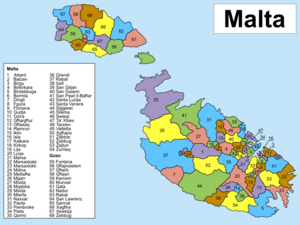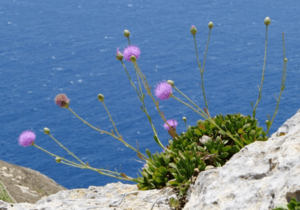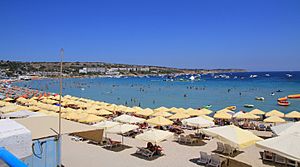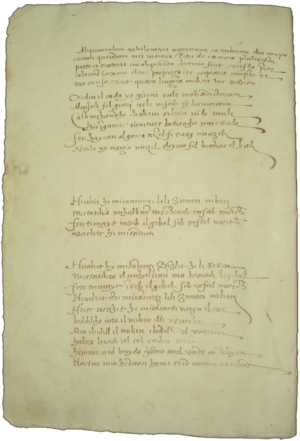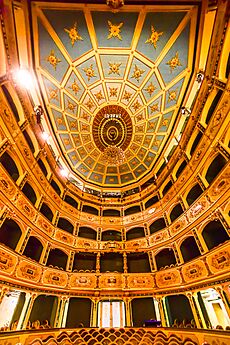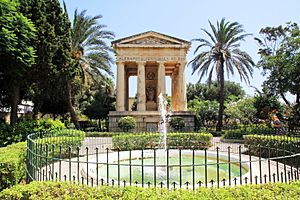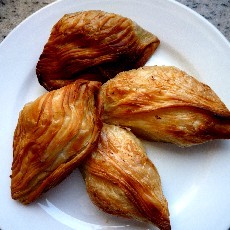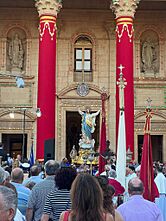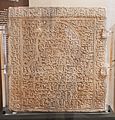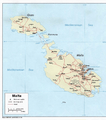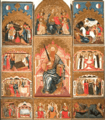Malta facts for kids
Quick facts for kids
Republic of Malta
Repubblika ta' Malta (Maltese)
|
|
|---|---|
![Location of Malta (green circle)– on the European continent (light green & dark grey)– in the European Union (light green) — [Legend]](/images/thumb/6/63/EU-Malta.svg/350px-EU-Malta.svg.png)
Location of Malta (green circle)
– on the European continent (light green & dark grey) |
|
| Capital | Valletta 35°54′N 14°31′E / 35.900°N 14.517°E |
| Largest administrative unit | St. Paul's Bay |
| Official languages | |
| Other languages | Maltese Sign Language Italian |
| Ethnic groups
(2021)
|
|
| Religion
(2021)
|
|
| Demonym(s) | Maltese |
| Government | Unitary parliamentary republic |
| Myriam Spiteri Debono | |
| Robert Abela | |
| Legislature | Parliament of Malta |
| Independence
from the United Kingdom
|
|
| 21 September 1964 | |
|
• Republic
|
13 December 1974 |
| Area | |
|
• Total
|
316 km2 (122 sq mi) (187th) |
|
• Water (%)
|
0.001 |
| Population | |
|
• 2021 census
|
542,051 |
|
• Density
|
1,649/km2 (4,270.9/sq mi) (8th) |
| GDP (PPP) | 2024 estimate |
|
• Total
|
|
|
• Per capita
|
|
| GDP (nominal) | 2024 estimate |
|
• Total
|
|
|
• Per capita
|
|
| Gini (2020) | ▲ 31.4 medium |
| HDI (2022) | very high · 25th |
| Currency | Euro (€) (EUR) |
| Time zone | UTC+1 (Central European Time) |
|
• Summer (DST)
|
UTC+2 (Central European Summer Time) |
| Driving side | left |
| Calling code | +356 |
| ISO 3166 code | MT |
| Internet TLD | .mt |
|
|
Malta ( MOL-tə MAWL-tə), officially the Republic of Malta, is an island country in Southern Europe located in the Mediterranean Sea, between Sicily and North Africa. It consists of an archipelago 80 km (50 mi) south of Italy, 284 km (176 mi) east of Tunisia, and 333 km (207 mi) north of Libya. The two official languages are Maltese and English. The country's capital is Valletta, which is the smallest capital city in the EU by both area and population.
With a population of about 542,000 over an area of 316 km2 (122 sq mi), Malta is the world's tenth-smallest country by area and the ninth most densely populated.
Malta is a developed country with an advanced high-income economy. It is heavily reliant on tourism, attracting both travelers and a growing expatriate community with its warm climate, numerous recreational areas, and architectural and historical monuments, including three UNESCO World Heritage Sites: Ħal Saflieni Hypogeum, Valletta, and seven megalithic temples which are some of the oldest free-standing structures in the world.
Contents
Name
The name Melítē—shared by the Croatian island Mljet in antiquity—literally means "place of honey" or "sweetness", derived from the combining form of méli (μέλι, "honey" or any similarly sweet thing) and the suffix -ē (-η). The ancient Greeks may have given the island this name after Malta's endemic subspecies of bees.
History
Malta has been inhabited since about 5900 BC. Its location in the centre of the Mediterranean has historically given it great geostrategic importance, with a succession of powers having ruled the islands and shaped its culture and society. These include the Phoenicians, Carthaginians, Greeks, and Romans in antiquity; the Arabs, Normans, and Aragonese during the Middle Ages; and the Knights Hospitaller, French, and British in the modern era. Malta came under British rule in the early 19th century and served as the headquarters for the British Mediterranean Fleet. It was besieged by the Axis powers during World War II and was an important Allied base for North Africa and the Mediterranean. Malta achieved independence in 1964, and established its current parliamentary republic in 1974. It has been a member state of the Commonwealth of Nations and the United Nations since independence; it joined the European Union in 2004 and the eurozone monetary union in 2008.
Politics
Malta is a republic.
The unicameral parliament is made up of the president of Malta and the House of Representatives (Maltese: Kamra tad-Deputati). The president of Malta, a largely ceremonial position, is appointed for a five-year term by a resolution of the House of Representatives carried by a simple majority. The House of Representatives has 65 members, elected for a five-year term in 13 five-seat electoral divisions, called distretti elettorali. Members of the House of Representatives are elected by direct universal suffrage through single transferable vote every five years.
The head of state in Malta is the president of the republic. The president appoints the prime minister.
Administrative divisions
Malta has had a system of local government since 1993, based on the European Charter of Local Self-Government. The country is divided into six regions (one of them being Gozo), with each region having its own Regional Council, serving as the intermediate level between local government and national government. The regions are divided into local councils, of which there are currently 68 (54 in Malta and 14 in Gozo). The six districts (five on Malta and the sixth being Gozo) serve primarily statistical purposes.
Each council is made up of a number of councillors (from 5 to 13, depending on and relative to the population they represent). A mayor and a deputy mayor are elected by and from the councillors. The executive secretary, who is appointed by the council, is the executive, administrative and financial head of the council. Councillors are elected every four years through the single transferable vote. Due to system reforms, no elections were held before 2012. Since then, elections have been held every two years for an alternating half of the councils.
Local councils are responsible for the general upkeep and embellishment of the locality (including repairs to non-arterial roads), allocation of local wardens, and refuse collection; they also carry out general administrative duties for the central government such as the collection of government rents and funds and answer government-related public inquiries. Additionally, a number of individual towns and villages in the Republic of Malta have sister cities.
Geography
Malta is an archipelago in the central Mediterranean (in its eastern basin), some 80 km (50 mi) from southern Italy across the Malta Channel. Only the three largest islands—Malta (Maltese: Malta), Gozo (Għawdex), and Comino (Kemmuna)—are inhabited. The islands of the archipelago lie on the Malta plateau, a shallow shelf formed from the high points of a land bridge between Sicily and North Africa that became isolated as sea levels rose after the last ice age. The archipelago is located on the African tectonic plate. Malta was considered an island of North Africa for centuries. The seabed surrounding Malta's islands retains traces of ancient geomarine features, suggesting potential archaeological discoveries that could shed light on the region's prehistoric environment.
Numerous bays along the indented coastline of the islands provide good harbours. The landscape consists of low hills with terraced fields. The highest point in Malta is Ta' Dmejrek, at 253 m (830 ft), near Dingli. Although there are some small rivers at times of high rainfall, there are no permanent rivers or lakes on Malta. However, some watercourses have fresh water running all year round at Baħrija near Ras ir-Raħeb, at l-Imtaħleb and San Martin, and at Lunzjata Valley in Gozo.
Phytogeographically, Malta belongs to the Liguro-Tyrrhenian province of the Mediterranean region within the Boreal Kingdom. According to the WWF, the territory of Malta belongs to the terrestrial ecoregion of Tyrrhenian-Adriatic sclerophyllous and mixed forests.
The following uninhabited minor islands are part of the archipelago:
- Barbaġanni Rock (Gozo)
- Cominotto (Kemmunett)
- Dellimara Island (Marsaxlokk)
- Filfla (Żurrieq)/(Siġġiewi)
- Fessej Rock
- Fungus Rock (Il-Ġebla tal-Ġeneral), (Gozo)
- Għallis Rock (Naxxar)
- Ħalfa Rock (Gozo)
- Large Blue Lagoon Rocks (Comino)
- Islands of St. Paul/Selmunett Island (Mellieħa)
- Manoel Island, which connects to the town of Gżira, on the mainland via a bridge
- Mistra Rocks (San Pawl il-Baħar)
- Taċ-Ċawl Rock (Gozo)
- Qawra Point/Ta' Fraben Island (San Pawl il-Baħar)
- Small Blue Lagoon Rocks (Comino)
- Sala Rock (Żabbar)
- Xrobb l-Għaġin Rock (Marsaxlokk)
- Ta' taħt il-Mazz Rock
Climate
Malta has a Mediterranean climate (Köppen climate classification Csa), with mild winters and hot summers, hotter in the inland areas. Rain occurs mainly in autumn and winter, with summer being generally dry.
The average yearly temperature is around 23 °C (73 °F) during the day and 15.5 °C (59.9 °F) at night. In the coldest month – January – the typical maximum temperature ranges from 12 to 18 °C (54 to 64 °F) during the day and minimum 6 to 12 °C (43 to 54 °F) at night. In the warmest month – August – the typical maximum temperature ranges from 28 to 34 °C (82 to 93 °F) during the day and minimum 20 to 24 °C (68 to 75 °F) at night. Amongst all capitals in the continent of Europe, Valletta – the capital of Malta has the warmest winters, with average temperatures of around 15 to 16 °C (59 to 61 °F) during the day and 9 to 10 °C (48 to 50 °F) at night in the period January–February. In March and December average temperatures are around 17 °C (63 °F) during the day and 11 °C (52 °F) at night. Large fluctuations in temperature are rare. Snow is very rare, although snowfalls have been recorded in the last century, the last one in 2014.
The average annual sea temperature is 20 °C (68 °F), from 15–16 °C (59–61 °F) in February to 26 °C (79 °F) in August. In the 6 months – from June to November – the average sea temperature exceeds 20 °C (68 °F).
The annual average relative humidity is high, averaging 75%, ranging from 65% in July (morning: 78% evening: 53%) to 80% in December (morning: 83% evening: 73%).
Sunshine duration hours total around 3,000 per year, from an average 5.2 hours of sunshine duration per day in December to an average above 12 hours in July. This is about double that of cities in the northern half of Europe, for comparison: London – 1,461; however, in winter it has up to four times more sunshine; for comparison: in December, London has 37 hours of sunshine whereas Malta has above 160.
| Climate data for Malta (Luqa in the south-east part of main island, 1991–2020) | |||||||||||||
|---|---|---|---|---|---|---|---|---|---|---|---|---|---|
| Month | Jan | Feb | Mar | Apr | May | Jun | Jul | Aug | Sep | Oct | Nov | Dec | Year |
| Mean daily maximum °C (°F) | 15.7 (60.3) |
15.7 (60.3) |
17.4 (63.3) |
20.0 (68.0) |
24.2 (75.6) |
28.7 (83.7) |
31.7 (89.1) |
32.0 (89.6) |
28.6 (83.5) |
25.0 (77.0) |
20.8 (69.4) |
17.2 (63.0) |
23.1 (73.6) |
| Daily mean °C (°F) | 12.9 (55.2) |
12.6 (54.7) |
14.1 (57.4) |
16.4 (61.5) |
20.1 (68.2) |
24.2 (75.6) |
26.9 (80.4) |
27.5 (81.5) |
24.9 (76.8) |
21.8 (71.2) |
17.9 (64.2) |
14.5 (58.1) |
19.5 (67.1) |
| Mean daily minimum °C (°F) | 10.1 (50.2) |
9.5 (49.1) |
10.9 (51.6) |
12.8 (55.0) |
15.8 (60.4) |
19.6 (67.3) |
22.1 (71.8) |
23.0 (73.4) |
21.2 (70.2) |
18.4 (65.1) |
14.9 (58.8) |
11.8 (53.2) |
15.9 (60.6) |
| Average precipitation mm (inches) | 79.3 (3.12) |
73.2 (2.88) |
45.3 (1.78) |
20.7 (0.81) |
11.0 (0.43) |
6.2 (0.24) |
0.2 (0.01) |
17.0 (0.67) |
60.7 (2.39) |
81.8 (3.22) |
91.0 (3.58) |
93.7 (3.69) |
580.7 (22.86) |
| Average precipitation days (≥ 1.0 mm) | 10.0 | 8.2 | 6.1 | 3.8 | 1.5 | 0.8 | 0.0 | 1.0 | 4.3 | 6.6 | 8.7 | 10.0 | 61 |
| Mean monthly sunshine hours | 169.3 | 178.1 | 227.2 | 253.8 | 309.7 | 336.9 | 376.7 | 352.2 | 270.0 | 223.8 | 195.0 | 161.2 | 3,054 |
| Source: Meteo Climate (1991–2020 Data), MaltaWeather.com (Sun data) | |||||||||||||
Flora
The Maltese islands are home to a wide diversity of indigenous, sub-endemic and endemic plants. They feature many traits typical of a Mediterranean climate, such as drought resistance. The most common indigenous trees on the islands are olive (Olea europaea), carob (Ceratonia siliqua), fig (Ficus carica), holm oak (Quericus ilex) and Aleppo pine (Pinus halepensis), while the most common non-native trees are eucalyptus, acacia and opuntia. Endemic plants include the national flower widnet il-baħar (Cheirolophus crassifolius), sempreviva ta' Malta (Helichrysum panormitanum subsp. melitense), żigland t' Għawdex (Hyoseris frutescens) and ġiżi ta' Malta (Matthiola incana subsp. melitensis) while sub-endemics include kromb il-baħar (Jacobaea maritima subsp. sicula) and xkattapietra (Micromeria microphylla). The biodiversity of Malta is severely endangered by habitat loss, invasive species and human intervention.
Economy
Malta's major resources are limestone, a favourable geographic location and a productive labour force. Malta produces only about 20 percent of its food needs, has limited fresh water supplies because of the drought in the summer, and has no domestic energy sources, aside from the potential for solar energy from its plentiful sunlight. The economy is dependent on foreign trade (serving as a freight trans-shipment point), manufacturing (especially electronics and textiles), and tourism. Film production has contributed to the Maltese economy.
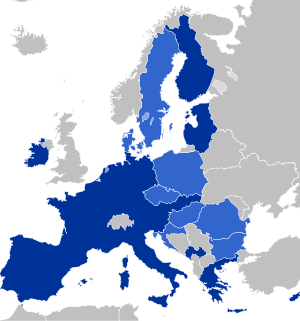
Maltese euro coins feature the Maltese cross on €2 and €1 coins, the coat of arms of Malta on the €0.50, €0.20 and €0.10 coins, and the Mnajdra Temples on the €0.05, €0.02 and €0.01 coins.
Tourism
Malta is a popular tourist destination, with 1.6 million tourists per year, three times more tourists visit than there are residents. Tourism infrastructure has increased dramatically over the years and a number of hotels are present on the island, although overdevelopment and the destruction of traditional housing is of growing concern. In 2019, Malta had a record year in tourism, recording over 2.1 million tourists in one single year.
In recent years, Malta has advertised itself as a medical tourism destination, and a number of health tourism providers are developing the industry. However, no Maltese hospital has undergone independent international healthcare accreditation. Malta is popular with British medical tourists, pointing Maltese hospitals towards seeking UK-sourced accreditation, such as with the Trent Accreditation Scheme.
Tourism in Malta contributes around 11.6 percent of the country's gross domestic product.
Demographics
As of the 2021 census, Maltese-born natives make up the majority of the island with 386,280 people out of a total population of 519,562. However, there are minorities, the largest of which by birthplace were: 15,082 from the United Kingdom, Italy (13,361), India (7,946), Philippines (7,784) and Serbia (5,935). Among racial origins for the non-Maltese, 58.1% of all identified as Caucasian, 22.2% Asian, 6.3% Arab, 6.0% African, 4.5% Hispanic or Latino and 2.9% more than one race.
Languages
The Maltese language (Maltese: Malti) is one of the two constitutional languages of Malta and is considered the national language. The second official language is English and hence laws are enacted both in Maltese and English.
Religion
In a survey held by Malta Today, the overwhelming majority of the Maltese population adheres to Christianity (95.2%) with Roman Catholicism as the main denomination (93.9%); 4.5% of the population declared themselves either atheist or agnostic.
Culture
The culture of Malta reflects the various cultures, that have come into contact with the Maltese Islands throughout the centuries.
Music
While Maltese music today is largely Western, traditional Maltese music includes what is known as għana. This consists of background folk guitar music, while a few people, generally men, take it in turns to argue a point in a sing-song voice. Music plays an important part in Maltese culture as each locality parades its own band club, on various occasions these being multiple per locality, and function to establish the thematic musical background to the various village feasts. The Malta Philharmonic Orchestra is recognized as Malta's foremost musical institution and is notable for being called to participate in important state events.
Contemporary music in Malta spans a variety of styles and sports international classical talents such as Miriam Gauci and Joseph Calleja, as well as non-classical music bands such as Winter Moods, and Red Electric, and singers like Ira Losco, Fabrizio Faniello, Glen Vella, Kevin Borg, Kurt Calleja, Chiara Siracusa, and Thea Garrett.
Literature
Documented Maltese literature is over 200 years old. However, a recently unearthed love ballad testifies to literary activity in the local tongue from the Medieval period. Malta followed a Romantic literary tradition, culminating in the works of Dun Karm Psaila, Malta's national poet. Subsequent writers like Ruzar Briffa and Karmenu Vassallo tried to estrange themselves from the rigidity of formal themes and versification.
The next generation of writers, including Karl Schembri and Immanuel Mifsud, widened the tracks further, especially in prose and poetry.
Architecture
Maltese architecture has been influenced by many different Mediterranean cultures and British architecture over its history. The first settlers on the island constructed Ġgantija, one of the oldest manmade freestanding structures in the world. The Neolithic temple builders (3800–2500 BC) endowed the numerous temples of Malta and Gozo with intricate bas-relief designs.
The Roman period introduced highly decorative mosaic floors, marble colonnades, and classical statuary, remnants of which are beautifully preserved and presented in the Roman Domus, a country villa just outside the walls of Mdina. The early Christian frescoes that decorate the catacombs beneath Malta reveal a propensity for eastern, Byzantine tastes. These tastes continued to inform the endeavours of medieval Maltese artists, but they were increasingly influenced by the Romanesque and Southern Gothic movements. Malta is currently undergoing several large-scale building projects, while areas such as the Valletta Waterfront and Tigné Point have been or are being renovated.
Art
Towards the end of the 15th century, Maltese artists, like their counterparts in Sicily, came under the influence of the School of Antonello da Messina, which introduced Renaissance ideals and concepts to the decorative arts in Malta.
The artistic heritage of Malta blossomed under the Knights of St. John, who brought Italian and Flemish Mannerist painters to decorate their palaces and the churches of these islands, most notably, Matteo Perez d'Aleccio, whose works appear in the Magisterial Palace and in the Conventual Church of St. John in Valletta, and Filippo Paladini, who was active in Malta from 1590 to 1595. For many years, Mannerism continued to inform the tastes and ideals of local Maltese artists.
The arrival in Malta of Caravaggio, who painted at least seven works during his 15-month stay on these islands, further revolutionised local art. Two of Caravaggio's most notable works, The Beheading of Saint John the Baptist and Saint Jerome Writing, are on display in the Conventual Church of St. John. His legacy is evident in the works of local artists Giulio Cassarino and Stefano Erardi. However, the Baroque movement that followed was destined to have the most enduring impact on Maltese art and architecture. The vault paintings of the Calabrese artist Mattia Preti transformed the Conventual Church St. John into a Baroque masterpiece. Melchior Gafà emerged as one of the top Baroque sculptors of the Roman School.
During the 17th and 18th century, Neapolitan and Rococo influences emerged in the works of the Italian painters Luca Giordano and Francesco Solimena, and these developments can be seen in the work of their Maltese contemporaries such as Gio Nicola Buhagiar and Francesco Zahra. The Rococo movement was greatly enhanced by the relocation to Malta of Antoine de Favray, who assumed the position of court painter to Grand Master Pinto in 1744.
Neo-classicism made some inroads among local Maltese artists in the late-18th century, but this trend was reversed in the early 19th century, as the local Church authorities – perhaps in an effort to strengthen Catholic resolve against the perceived threat of Protestantism during the early days of British rule in Malta – favoured and avidly promoted the religious themes embraced by the Nazarene movement. Romanticism, tempered by the naturalism introduced to Malta by Giuseppe Calì, informed the "salon" artists of the early 20th century, including Edward and Robert Caruana Dingli.
Parliament established the National School of Art in the 1920s. During the reconstruction period that followed the Second World War, the emergence of the "Modern Art Group", whose members included Josef Kalleya, George Preca, Anton Inglott, Emvin Cremona, Frank Portelli, Antoine Camilleri, Gabriel Caruana and Esprit Barthet greatly enhanced the local art scene. This group came together forming an influential pressure group known as the Modern Art Group, which played a leading role in the renewal of Maltese art. Most of Malta's modern artists have in fact studied in Art institutions in England, or on the continent, leading to a diversity of artistic expression that has remained characteristic of contemporary Maltese art. In Valletta, the National Museum of Fine Arts featured work from artists such as H. Craig Hanna. In 2018 the national collection of fine arts was put on display in the new National Museum of Art, MUŻA, at Auberge d'Italie in Valletta.
Cuisine
Maltese cuisine shows strong Sicilian and Italian influences as well as influences of English, Spanish, Maghrebin and Provençal cuisines. A number of regional variations can be noted as well as seasonal variations associated with the seasonal availability of produce and Christian feasts (such as Lent, Easter and Christmas). Food has been important historically in the development of a national identity in particular the traditional fenkata (i.e., the eating of stewed or fried rabbit). Potatoes are a staple of the Maltese diet as well.
A number of grapes are endemic to Malta, including Girgentina and Ġellewża. There is a strong wine industry, with significant production of wines using these native grapes, as well as locally grown grapes of other more common varietals. A number of wines have achieved Protected Designation of Origin, with wines produced from grapes cultivated in Malta and Gozo designated as "DOK" wines, that is Denominazzjoni ta' l-Oriġini Kontrollata.
Customs
A 2010 Charities Aid Foundation study found that the Maltese were the most generous people in the world, with 83% contributing to charity.
Maltese folktales include various stories about mysterious creatures and supernatural events. These were most comprehensively compiled by the scholar (and pioneer in Maltese archaeology) Manwel Magri in his core criticism "Ħrejjef Missirijietna" ("Fables from our Forefathers"). This collection of material inspired subsequent researchers and academics to gather traditional tales, fables and legends from all over the Archipelago. While giants, witches, and dragons feature in many of the stories, some contain entirely Maltese creatures like the Kaw kaw, Il-Belliegħa and L-Imħalla among others.
Festivals and events

Local festivals, similar to those in Southern Italy, are commonplace in Malta and Gozo, celebrating weddings, christenings and, most prominently, saints' days. On saints' days, in the morning, the festa reaches its apex with a High Mass featuring a sermon on the life and achievements of the patron saint. In the evening, a statue of the religious patron is taken around the local streets in solemn procession, with the faithful following in prayer. The atmosphere of religious devotion is preceded by several days of celebration and revelry: band marches, fireworks, and late-night parties. The largest festa is possibly that of the Assumption of Mary, which is celebrated in 8 parishes on the 15 August and in 2 other parishes the following Sunday.
Carnival (Maltese: il-karnival ta' Malta) has had an important place on the cultural calendar after Grand Master It is held during the week leading up to Ash Wednesday, and typically includes masked balls, fancy dress and grotesque mask competitions, lavish late-night parties, a colourful, ticker-tape parade of allegorical floats presided over by King Carnival (Maltese: ir-Re tal-Karnival), marching bands and costumed revellers.
Holy Week (Maltese: il-Ġimgħa Mqaddsa) starts on Palm Sunday (Ħadd il-Palm) and ends on Easter Sunday (Ħadd il-Għid).
Mnarja, or l-Imnarja (pronounced lim-nar-ya) is one of the most important dates on the Maltese cultural calendar. Officially, it is a national festival dedicated to the feast of Saints Peter and Paul. Its roots can be traced back to the pagan Roman feast of Luminaria (literally, "the illumination"), when torches and bonfires lit up the early summer night of 29 June. The festivities still commence today with the reading of the "bandu", an official governmental announcement, which has been read on this day in Malta since the 16th century. It is said that under the Knights, this was the one day in the year when the Maltese were allowed to hunt and eat wild rabbit, which was otherwise reserved for the hunting pleasures of the Knights. The close connection between Mnarja and rabbit stew (Maltese: "fenkata") remains strong today.
Isle of MTV is a one-day music festival produced and broadcast on an annual basis by MTV. The festival has been arranged annually in Malta since 2007, with major pop artists performing each year. 2012 saw the performances of worldwide acclaimed artists Flo Rida, Nelly Furtado and Will.i.am. Over 50,000 people attended, which marked the biggest attendance so far.
The Malta International Fireworks Festival has been arranged annually in the Grand Harbour of Valletta since 2003.
Sport
Football (soccer) is one of the most popular sports in Malta. Other popular sports include boċċi, horse racing, gostra, regatta, water polo, clay pigeon shooting, and motorsports.
In 2018 Malta hosted its first Esports tournament, 'Supernova CS:GO Malta', a Counter-Strike: Global Offensive tournament. Also since 2018, Malta has become the primary location for hosting the ESL Pro League.
Images for kids
-
The 1565 Siege of Malta: The bombardment of the bastion of Castille.
-
Ġgantija megalithic temple complex
-
The temple complex of Mnajdra
-
The lands which comprise modern-day Malta, were a part of the Byzantine Empire (The empire in 555 under Justinian the Great, at its greatest extent since the fall of the Western Roman Empire (its vassals in pink))
-
Roman mosaic from the Domvs Romana
-
The Maymūnah Stone, a Roman period marble stone, was reused as a 12th-century tombstone believed to have been found in Gozo.
-
Roger I of Sicily returned Malta to Christian rule
-
The heavily bomb-damaged Kingsway (now Republic Street) in Valletta during the Siege of Malta, 1942
-
Malta joined the European Union in 2004 and signed the Lisbon Treaty in 2007.
-
An Air Malta Airbus A320.
-
The St. Paul Polyptych dates to the early 15th century and is associated with the medieval Università and the Mdina cathedral. Featuring the style of the Catalan Gothic, it was probably made in the workshop of Lluis Borassa and is a testament to the strong Pauline tradition present on the islands since the Middle Ages.
-
Żejtun city centre Parish church
See also
 In Spanish: Malta para niños
In Spanish: Malta para niños





